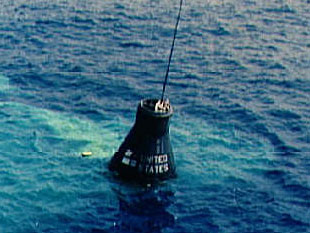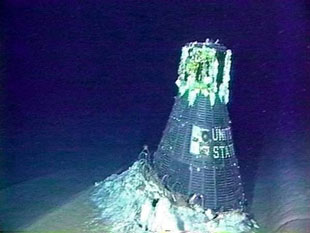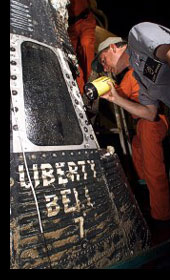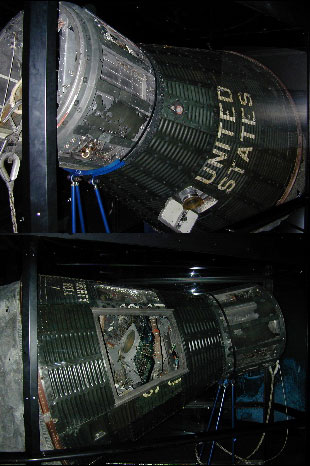|
|

|
Lost Spacecraft:
The Search for Liberty Bell 7
by Curt Newport
Apogee Books, 2002
Review by Larry McGlynn
There are some books you read and dream of emulating the events described by the author. Then there are those books you read and can participate in some of the events that occurred. For me, "Lost Spacecraft: The Search for the Liberty Bell 7" is one of those books.
As a technical diver, I have had the opportunity to visit many wrecks worldwide and searched the local New England waters for more. As a result, I found while reading "Lost Spacecraft" I could relate to some of the challenges described, albeit on a much smaller scale.

The Liberty Bell 7 holds the distinction of being the only manned spacecraft to fly above the upper reaches of the Earth's atmosphere and then sink to the bottom of one of Earth's oceans in the period of a couple hours. Curt Newport set a record in deep sea recovery by lifting the Liberty Bell 7 from a depth of 16,000 feet in the ocean.
In "Lost Spacecraft", Newport imparts the exuberance associated with those who have a true passion for their work. This excitement translates in written format to a fast, fun, and inspiring read.

Newport takes us from his days as a youth dreaming of the sea and space flight to recovering a Mercury capsule from 16,000 feet below the ocean. Along the way, he provides a technical perspective on the design and construction of the Mercury spacecraft as well as a basic history of the United States' first crewed space program.
The thorough research needed to reconstruct Virgil "Gus" Grissom's 1961 suborbital flight is provided in "Lost Spacecraft" by detailed interviews from the various participants of the Newport's mission. Though the July 1999 recovery attracted a good deal of public attention at the time, it is Newport's retelling that exposes the details of a project that began in 1985.
While preparing this review, I had the opportunity to exchange e-mails with Newport about his book and the recovery of the Liberty Bell 7. I caught Newport just as he returned from a National Geographic expedition to locate the Argentine cruiser, the General Belgrano, sunk during the Falkland Islands War.
Joining our discussion was Max Ary, former President and CEO of the Kansas Cosmosphere and Space Center, responsible for the restoration of the Liberty Bell 7.
How long ago did you start thinking about recovering the LB7?
Newport: I first starting investigating Liberty Bell 7 in 1984, then really got into [it] from 1985 to 1988. By then I had completed all of my basic research and it was a matter of finding a sponsor.
Ary: Actually my interest, relative to the Cosmosphere, in recovering the Liberty Bell 7 goes way back. In 1978, before the Cosmosphere opened, but when we were still trying to put together the space artifact collection, one of my many basic goals was to place on exhibit examples of all three of the early manned spacecraft [Mercury, Gemini and Apollo]. We knew when we were going to get the Gemini and Apollo's but we knew, because of the rarity of the Mercury, that it was going to be our biggest challenge.
When I realized that all of the available Mercury were on long-term exhibit, it occurred to me there was still one that might be made available, and that was LB7. Being from Kansas, and with no knowledge of the ocean, I didn't specifically see why there would be any problem in recovering something from 16,000 feet down. As they often say "ignorance is bliss".
After doing some preliminary research on location, depth, etc., I contacted a Captain Bartholomew who was head of the U.S. Navy deep-sea salvage efforts. After explaining that we had an interest in finding and recovering LB7, he became mildly interested. When he asked me what depth it was at and I told him three miles down, he began laughing uncontrollably.
As it turned out, in the late 1970's, there was no craft available to someone like me that could go to that depth. There was some top secret hardware from the military that might have been able to be used but, because of the Cold War, we were never made aware of it. Even though the Navy demonstrated to me the impossibility to recover LB7, it was something I never forgot about, even though we acquired an unflown Mercury spacecraft for the Cosmosphere in the early 1980's.
I would not hesitate to say there were few days between my first inspiration about LB7 and when we finally recovered it that my mind didn't at least drift toward the contemplation of recovering the spacecraft.
I do a lot of wreck diving and as someone who has sat in the back of a boat waiting the MAG (bottom finder) to confirm some numbers given by a fisherman, I have an understanding at a lesser level of what you go through and how it amazed me that you found the Liberty Bell 7.
Newport: I always felt the capsule could be found with the right side scan sonar. It's simply a matter of having sufficient time on site to properly search the area and investigate what you find.
How did you determine your search area and pattern you planned to use during the expedition?
Newport: It was based on the combination of radar (FPS-16) and ship-based locations (from the USS Randolph) and took into account the wind drift on main parachute as well as the accuracy of the tracking radars.
We elected to use the Ocean Explorer 6000 sonar on the 1000 meter swath, as that would allow us to operate the sonar in both the 33 kHz and 100 kHz frequencies at the same time. Our along track resolution was about 0.5 meters. Our initial pattern through the area used minimal overlap - the final phase was to do several fill in lines to cover the area directly underneath the sonar.
While a large shipwreck could not hide directly under the sonar, a capsule might not show up, hence the requirement for the fill in lines.
How did you pick the coordinates that turned out to the LB7 site?
Newport: I used the locations published by NASA in their Post Flight Memorandum decampments, trajectory analysis, and firing test reports. Both the Space Task Group and MSFC listed splashdown locations or positions at Loss of Signal (from the tracking radar in the automatic beacon mode). The MSFC locations were very close to the STG positions, less than 0.5 nm difference.
The capsule was found about 1.0 nm west my estimate of the impact location based taking into account the wind drift on main parachute (about 1.3 nm to the NW).
Can you describe your feelings that moment you grasped the capsule in your hands as it was swung aboard the ship?
Newport: I guess I had moments of disbelief. I mean you spend 14 years of your life imagining the moment, but when it actually happens, it doesn't feel like anything special. I was simply relieved that we got it back OK.
In fact, I knew that everything was going to be fine after we found the capsule. We were going to get it back eventually.
On board ship, what was it like working and listening to Guenter Wendt, Jim Lewis and Curt Newport?
Ary: I found it extremely fascinating sharing time with these three people.
I will never forget the first time I met Jim Lewis. I was at the Johnson Space Center back in the l980's talking to an engineering friend. I explained to him my hope of one day recovering LB7. He got a crazed look on his face and basically said "hold that thought for a minute" and raced out the door. Shortly after, he returned with Jim Lewis in tow and introduced me to him.
I recounted my story again about the hope of recovering LB7. Jim then identified himself as the helicopter pilot who cut it loose. I was flabbergasted and thought what a wonderful chance encounter. It was really great to spend all of those weeks on ship getting to know Jim who has become a good friend.
As for Guenter, of course he was a legend. I never had a chance to meet him until we cruised together. There were many long days that could have been sheer boredom when we were having breakdowns and inactivity if it had not been for Guenter's constant flow of wonderful stories about his experiences in the space program. Many of those stories would wind up in his best selling book a couple of years ago.
As for Curt, I had gotten to know him very well during the 13 years that we had shared hundreds of phone calls about our hopes and dreams of recovering LB7. He is an extremely intense and focused individual and I give him total credit for keeping the project alive through all of the years.
What did Guenter, Jim and Max have to say when you brought the LB7 on board the Ocean Project?
Newport: I don't remember them saying anything in particular other than what's in the film (Discovery Channel's "In Search of the Liberty Bell 7").
I think they were all amazed at the condition of the capsule. However, it was about what I had expected all along, although the interior was in worst shape than I imagined.
 What did you first think of the interior damage as you saw the capsule as it arrived on deck? What did you first think of the interior damage as you saw the capsule as it arrived on deck?
Ary: Although we were greatly encouraged by the exterior condition of LB7, after recovery we were quite discouraged when we saw the interior.
The video we saw of the interior of the spacecraft, when it was still on the ocean floor, looked promising. Everything still seemed to be in place. That turned out to be just a façade; everything was in place but was just hanging on with a molecule or two. As soon as it started to be raised, virtually any aluminum based components crashed to the bottom of the spacecraft. They had deteriorated quite badly through what we later termed to be electrolytic action.
I have to admit, when the spacecraft arrived on deck and we realized the commitment we had made to Discovery to restore the spacecraft, I was a little concerned about how we were going to be able to deliver on our promise. After we got it back to Hutchinson and started to remove the thousands of individual components, I constantly reminded myself of the old restoration creed of "don't become overwhelmed by the size of the project; only look at it one piece at a time". By doing this, it becomes a workable and doable project. Obviously that mentality paid off for us.
How long did it take to restore the capsule and did you learn any new restoration techniques during the reconstruction of the Liberty Bell 7?
Ary: One of the most extraordinary aspects of what our staff was able to do to restore the spacecraft was that it was able to accomplish this project in just slightly more than six months.
The spacecraft was disassembled into an estimated 25,000 to 35,000 pieces. Each piece was methodically cleaned, preserved and sealed and then completely reassembled. Many of the pieces required extensive detective work of trying to figure out where they came from. There were hundreds of components lying in the muck at the bottom of the craft such as tiny nuts, bolts, gears, electrical components, etc. that had corroded away and become detached from the original hardware. We had to figure out where everything went.
In any restoration project you learn new techniques to deal with the unique challenges that every project has. The primary challenge we had with LB7 was not so much the fact that it had been setting in salt water for 38 years, but that it had been subjected to over 7,000 lbs. per sq. inch of water pressure. Many sealed areas of the spacecraft had filled with salt water because of the pressure. Hundreds of honeycomb areas of the couch, for example, which were totally sealed in fiberglass, had filled with water. Using custom built heated vacuum chambers, which we had never used before, we were able to get virtually all of the water out of the spacecraft and everything resealed.
What are the future plans for the Liberty Bell 7 after it's national tour?

Ary: After Liberty Bell 7 comes off its national tour, it will find a permanent home at the Cosmosphere. It is the only flown manned American spacecraft that is not owned by the Smithsonian and whose title has been given by both NASA and the Smithsonian to the Cosmosphere.
My original plans were to replace the exhibited unmanned Mercury spacecraft with LB7 and to incorporate as much of the existing exhibit that is now on tour into the display. [Ary is currently the Executive Director at the Omniplex Museum Complex in Oklahoma City, OK]
Do you have any future plans to recover any other space related objects (like a Saturn V 1st stage)?
Newport: There had been some talk about looking for the S1-C stages from either Apollo 11 or 13, though no funding has been forthcoming to date. It would be an interesting project, to say the least.
If at all possible, get the chance to visit the display of the Liberty Bell 7 as it continues it's tour around the country, or meet Curt Newport who plans to attend the Washington DC autograph show this May. In the meantime, read the book to get an idea of what went into the recovery of America's only Lost Spacecraft.
|

© 2022 collectSPACE.com All rights reserved.
Questions? E-mail contact@collectspace.com
|
|

|

|





 What did you first think of the interior damage as you saw the capsule as it arrived on deck?
What did you first think of the interior damage as you saw the capsule as it arrived on deck?